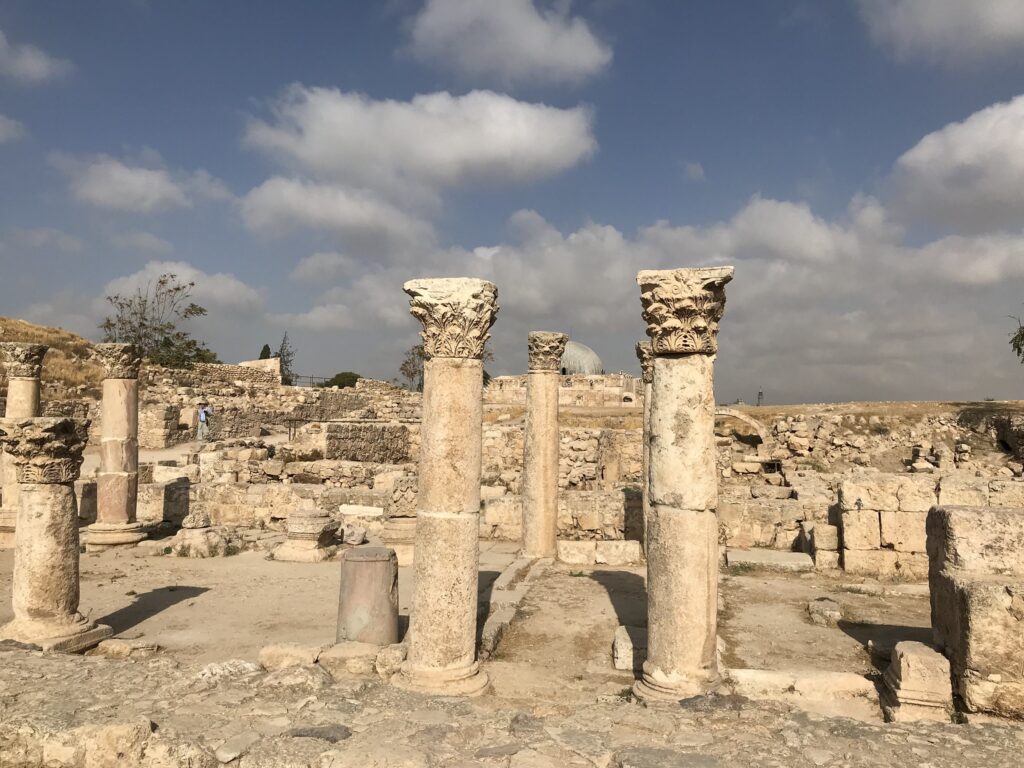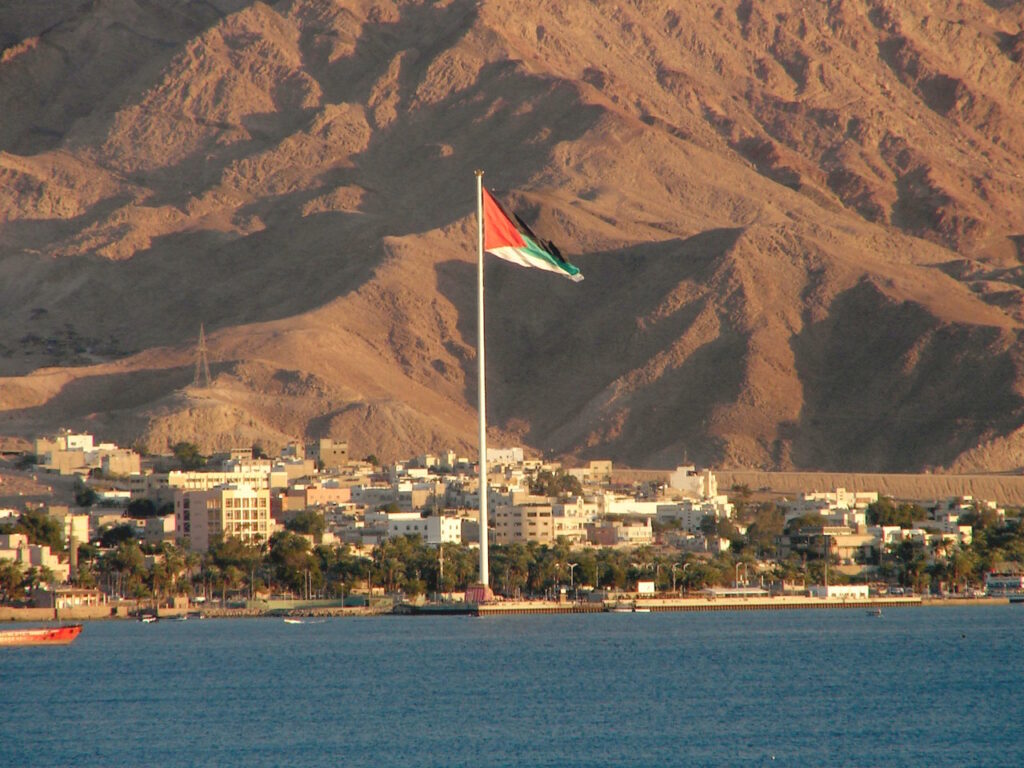Quick facts about Jordan:
- Population: Approximately 10 million people.
- Capital: Amman.
- Largest City: Amman.
- Official Language: Arabic.
- Other Languages: English is widely understood and used in business and education.
- Currency: Jordanian Dinar (JOD).
- Government: Unitary parliamentary constitutional monarchy.
- Major Religion: Islam, predominantly Sunni.
- Geography: Located in the Middle East, bordered by Saudi Arabia to the south and east, Iraq to the northeast, Syria to the north, and Israel and the West Bank to the west.
Fact 1: The name of the country Jordan is related to a river from the Bible
The Jordan River flows through the region, serving as a boundary and a focal point in various biblical narratives.
In Hebrew, the name “Jordan” is derived from the root word “yarad,” which means “to descend” or “to flow down.” This name reflects the river’s characteristic of flowing from the Sea of Galilee in the north to the Dead Sea in the south, descending through the Jordan Rift Valley.
The Jordan River is closely associated with several key events and figures in the Bible. It is famously known as the site where John the Baptist baptized Jesus Christ. Additionally, the crossing of the Jordan River by the Israelites under Joshua’s leadership marked their entry into the Promised Land after their exodus from Egypt.

Fact 2: The Dead Sea at Jordan is the lowest place on earth
The Dead Sea, located at the border of Jordan and Israel, is renowned as the lowest place on Earth’s surface. It sits approximately 430 meters (1,411 feet) below sea level, making it the Earth’s lowest elevation on land. This unique geographical feature contributes to the Dead Sea’s remarkable salinity, which is about ten times higher than that of the world’s oceans. The high salt content makes it easier for individuals to float effortlessly in its waters, a distinctive experience for visitors to the region.
Fact 3: The capital of Jordan is one of the oldest cities in the world
The capital of Jordan, Amman, is indeed one of the oldest continuously inhabited cities in the world, with a history dating back several millennia. Originally known as “Philadelphia” during its Greco-Roman period, Amman’s strategic location contributed to its longevity and significance throughout history.
Archaeological evidence indicates that settlements existed in the area of modern-day Amman as far back as the Neolithic period (7000-5000 BCE). The city’s prominence grew during the Bronze Age and Iron Age, when it was known as “Rabbath Ammon” and served as the capital of the Ammonite kingdom.
Under various rulers, including the Greeks, Romans, and Byzantines, Amman continued to flourish as an important regional center due to its strategic location along ancient trade routes. It was during the Roman period that the city was formally named Philadelphia, after the ruler Philadelphus of Ptolemaic Egypt.

Fact 4: There are many archaeological sites in Jordan
The region of Jordan is rich with archaeological sites that bear witness to the diverse empires and civilizations that have inhabited the area throughout history. These sites span various periods and reflect the cultural, religious, and political significance of Jordan’s strategic location in the ancient world.
Some notable archaeological points in Jordan include:
- Petra: Known as the “Rose City,” Petra is a UNESCO World Heritage site and one of Jordan’s most famous archaeological wonders. Built by the Nabataeans around 300 BCE, Petra features impressive rock-cut architecture and served as a major trading hub and caravan city.
- Jerash: Located north of Amman, Jerash is an exceptionally well-preserved Greco-Roman city. It flourished during the Roman period and contains impressive ruins such as temples, theaters, and colonnaded streets.
- Amman Citadel: Situated in the heart of Amman, the Citadel is an ancient site with evidence of occupation dating back to the Bronze Age. It features ruins from various periods, including Roman, Byzantine, and Umayyad.
- Umm Qais (Gadara): This archaeological site in northern Jordan overlooks the Sea of Galilee and the Golan Heights. It was an ancient Greco-Roman city known for its spectacular views and well-preserved ruins.
- Qasr Amra: A desert castle and UNESCO World Heritage site, Qasr Amra dates back to the early Islamic period (8th century CE). It is famous for its well-preserved frescoes depicting scenes of daily life and mythical figures.
- Madaba: Known for its Byzantine-era mosaics, particularly the famous Madaba Map, which depicts the Holy Land in the 6th century CE.
Note: When planning a self-drive tour of historical sites, check if you need an International Driver’s License in Jordan to rent and drive a car.
Fact 5: There are almost no forests in Jordan, less than 2% of the territory
Jordan is predominantly arid and characterized by desert landscapes, which limits the presence of forests in the country. Less than 2% of Jordan’s territory is covered by forests or woodlands. This scarcity of forested areas is primarily due to the country’s arid climate, limited precipitation, and high evaporation rates, which pose significant challenges for tree growth and vegetation.
The majority of Jordan’s natural vegetation consists of drought-resistant shrubs, grasses, and desert plants adapted to the arid conditions. These plants play a crucial role in stabilizing soils, preventing erosion, and supporting local wildlife in the desert environment.

Fact 6: The middle east is rich in oil, but not Jordan
The Middle East region is renowned for its vast oil reserves, which have significantly influenced global energy markets and geopolitical dynamics. Countries such as Saudi Arabia, Iraq, Iran, Kuwait, and the United Arab Emirates are among the world’s largest oil producers and exporters.
However, Jordan is an exception in the Middle East when it comes to oil resources. Unlike its oil-rich neighbors, Jordan has limited oil reserves and production capabilities. The country’s geological formations have not yielded significant quantities of oil compared to other parts of the region. As a result, Jordan relies heavily on imported oil and natural gas to meet its energy needs and fuel its economy.
Fact 7: Jordan has made great progress in introducing renewable energy
Despite its limited natural resources, including oil, Jordan has prioritized renewable energy to enhance energy security, reduce reliance on imports, and mitigate environmental impacts.
Key developments in Jordan’s renewable energy sector include:
- Solar Energy: Jordan has abundant solar resources, making solar power a primary focus of its renewable energy strategy. The country has implemented several large-scale solar projects, including the Ma’an Solar Power Plant and the Quweira Solar Power Plant, which contribute to its renewable energy capacity.
- Wind Energy: Wind power is also gaining traction in Jordan, particularly in areas with favorable wind conditions. The Tafila Wind Farm, for example, is Jordan’s first utility-scale wind farm and has added significant capacity to the country’s renewable energy portfolio.

Fact 8: The ancient Roman city of Jerash is one of the best preserved outside of Italy
The ancient Roman city of Jerash in Jordan stands as a testament to the enduring legacy of Roman civilization outside of Italy. Its remarkably well-preserved ruins provide a vivid glimpse into the grandeur and urban planning of a thriving provincial city during the Roman Empire. Jerash’s architectural splendor includes colonnaded streets, temples, theaters, and public squares, all meticulously laid out in a grid-like pattern typical of Roman urban design.
One of the most iconic features of Jerash is the Oval Plaza, a spacious public square surrounded by Ionic columns and paved with stones. This plaza served as the vibrant heart of civic and commercial activities, bustling with traders, performers, and citizens going about their daily lives. Nearby, the South Theatre, renowned for its impressive acoustics and seating capacity for up to 3,000 spectators, hosted theatrical performances and cultural events, showcasing the city’s cultural richness and entertainment.
Fact 9: Jordan has access to the Red Sea through the Gulf of Aqaba
The Gulf of Aqaba is a northeastern extension of the Red Sea located between the Sinai Peninsula (Egypt) and the Arabian Peninsula (Saudi Arabia and Jordan). Jordan’s only coastline is along the northern shore of the Gulf of Aqaba, where the port city of Aqaba is situated.
Aqaba serves as Jordan’s primary maritime gateway to the Red Sea region. It is strategically significant for Jordan’s trade and tourism, offering access to international shipping routes and facilitating economic activities related to shipping, fishing, and tourism along the Red Sea coast.

Fact 10: Many movies have been filmed in Jordan
One of the most famous films shot in Jordan is “Lawrence of Arabia” (1962), which used the stunning desert landscapes of Wadi Rum as a backdrop for its epic scenes. The iconic red sand dunes and rock formations of Wadi Rum have since been featured in numerous other films, including “The Martian” (2015), “Transformers: Revenge of the Fallen” (2009), and “Rogue One: A Star Wars Story” (2016).
Additionally, the ancient city of Petra has been a popular filming location. Its impressive rock-cut architecture, including the iconic Treasury (Al-Khazneh), has been featured in films such as “Indiana Jones and the Last Crusade” (1989) and “The Mummy Returns” (2001).
Other films shot in Jordan include “Red Sea Diving Resort” (2019), based on true events, which used the coastal city of Aqaba and its surrounding waters, and “Promised Land” (2012), which filmed in various locations across the country.

Published June 30, 2024 • 8m to read





